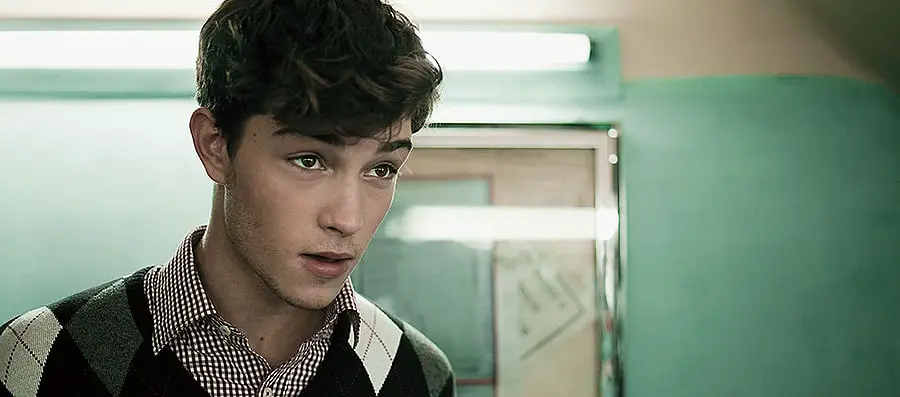
If you’ve been mewing for a couple of months, you’re probably waiting for people to notice your facial changes. The basis of good mewing practice involves proper tongue posture and committing for years. Mewing then results in remarkable facial changes that can give you an extra confidence boost.
Years of proper mewing will bring the following facial changes: forward facial growth, facial upswing, improved facial plane, more chin projection, shorter face, balanced forehead, hunter eyes, improved cheekbones, prominent jawline, improved teeth alignment, better gonial angle, and an improved nose, lip, and philtrum shape.
Although it has always been a controversial topic, we can’t deny the fact that mewing works. Mewing has exploded in popularity, and we’ll show the different changes that happen to the face when a person fully commits to mewing.
Most of us are not born with model-like facial features, but thanks to mewing, we are given a chance to make the most of our genetics. Here are some of the facial changes that consistent mewing practice can offer.
Forward Facial Growth
Forward facial growth is the main thing mewing accomplishes. This is pretty much our main goal since a forward grown face is both healthy and attractive. This gif shows an example of forward growth from mewing:
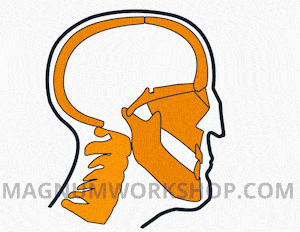
You’ll know you achieved forward growth when your face appears wider from a side profile and you have more room under your mandible:
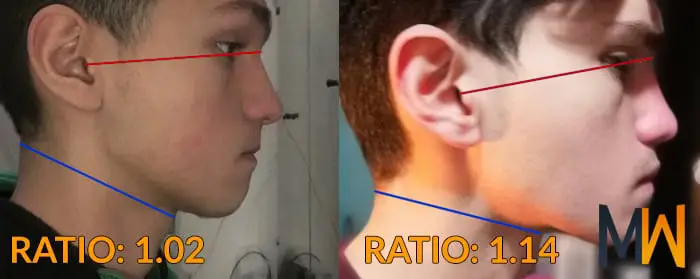
In the above picture, the red line increases relative to the blue line because the face has grown forward.
Facial Upswing
Facial upswing goes hand in hand with facial forward growth. Essentially what’s happening is the whole face appears to be rotating counterclockwise as the maxilla shortens, and the mandible gets pushed up and forward.
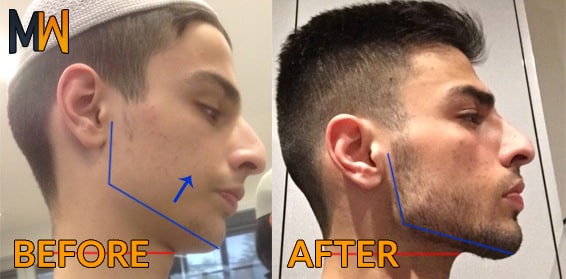
Even though his posture is slightly different, this picture still illustrates a good example of facial upswing. The more your maxilla is moved upwards, the less you will have to tilt your head up. As a result, the face appears to swing up. What you get as a result is a jawline that sticks out of the body instead of seeming to melt into the neck.
Facial Plane and Chin Projection
The mandible is responsible for the position of the chin while the surrounding tissue affects how the chin appears.
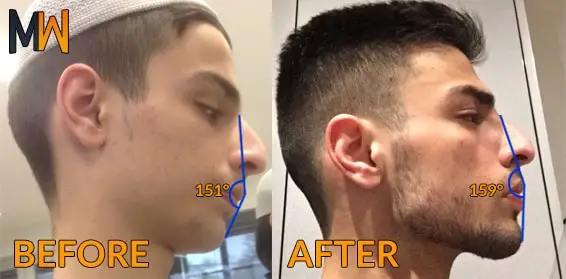
A receding chin significantly affects the aesthetics of the face. Mewing helps with a receding chin since it can help the mandible grow forward, as seen in the above image. Moving the maxilla upward also allows the lower jaw to swing up. This facial upswing helps pull your chin forward.
However, after puberty, it’s harder to fix a receding chin with just mewing. A chin is a highly heritable trait. What mewing can do is help with counterclockwise rotation of the face to help with the perceived appearance of the jawline and therefore the chin, such as in this example:
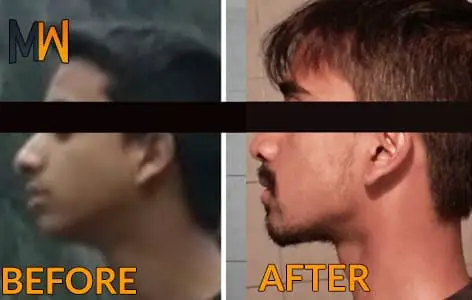
Shorter Face
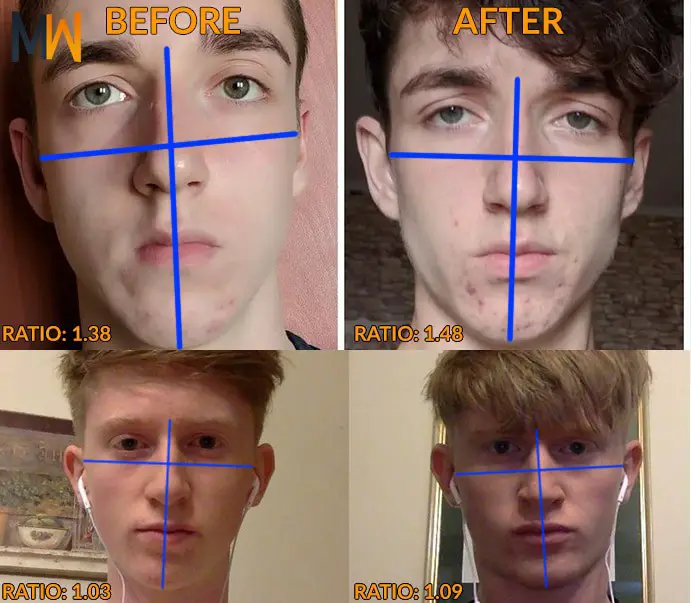
A shorter face is one of the hallmark changes of mewing since our goal is to move the maxilla upwards through tongue posture. Most successful mewers will have a shorter face.

If you let your tongue rest at the bottom of your mouth, keep your teeth apart, or regularly breathe through your mouth, this results in an elongated facial structure. By keeping your tongue on the roof of your mouth, you are preventing your face from sagging due to gravity, and you are getting a more compact midface.
Less Slanted Forehead
Not many of us are aware of what our body posture is really like unless someone points it out to us directly. People who are not consciously aware of their body posture will usually have an anterior head carriage, meaning that their head is sticking out in front of their chest. If your whole head moves forward, your forehead will also appear slanted because you have to turn your head up. These effects compound over time.
To get a sense of how this works, it’s helpful to have some general knowledge of skull shapes. Check out the Looks Theory episodes on male and female skulls:
Over time, the occipitofrontalis muscle (forehead muscle) ends up tightening due to forward head carriage and improper posture. To ensure this doesn’t happen to you, make sure to practice proper skull posture by tilting your head down.
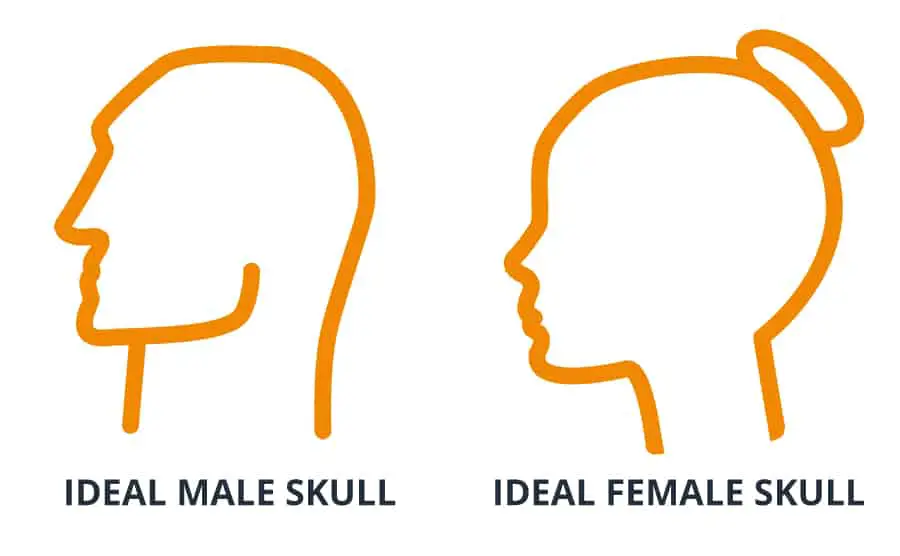
Lip and Philtrum Shape
You might notice some individuals have a protruding lower lip. This is not entirely genetic. An uneven lower lip is pretty standard for people with longer faces. A person who has a longer face will need his lip muscles, particularly the mentalis and orbicularis oris, to work extra hard to be able to close the mouth.
When the mentalis muscle detects that the mouth is not closed for extended periods, it will try to help by pushing the lower lip directly upward. The force exerted by your mentalis muscle gives overlapping upper and lower lips.
People with excellent tongue posture have balanced upper and lower lips. It may even look like their lips are the same size. Having perfectly sized lips is a result of proper facial growth since the muscles that pull on the lips are not straining to keep the mouth closed.
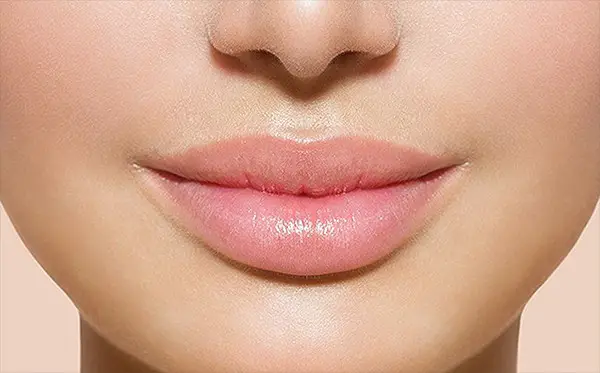
The area between the mouth and nose (the philtrum) will become more curved with mewing. Changes in the philtrum occur with mewing because the maxilla grows to a more forward position, causing the teeth to push on the lip. At the same time, the angle between the philtrum and the nose decreases.


Fixing Nose Size & Shape
Your nose will not magically change size. But mewing can make the nose seem less prominent by making the surrounding bones and tissues project forward in comparison. Changes in the nose area occur because the maxilla is moving forward and upwards.
This Reddit post is an excellent example of how mewing affects the shape of the nose.

Mewing also leads to more support for the nasal tissues, which over time, can fix a prominent hump (provided that the hump is not genetic).
Hunter Eyes
Not having good tongue posture will have an impact on both the eye and cheek area. The sunken eye look occurs because the maxilla has sunk with age. However, with years of mewing, you will push the maxilla up, which leads to more eye support. Your eyes will become more hooded. You’ll get hunter eyes and a reduced tear trough area.

Improved Cheekbones

The force of the tongue goes into the maxilla and radiates up into the cheekbones. Over time, mewing will make your cheekbones more prominent.

The maxilla will move upwards, and the ramus length will increase. On top of that, the masseter muscle will hypertrophy a little. All of this will create extra space in the cheek hollow area, giving you the sunken cheek look.
More Prominent Jawline
Getting a prominent jawline is probably the main reason why people engage in mewing in the first place. Who doesn’t want a well-defined jawline that is worthy of being on the cover of every major magazine? For men, a sharp-looking jawline is synonymous with masculinity and self-confidence.
Even before any bone changes occur with mewing, you will notice soft tissue changes in the submental area (the area under the jaw). The muscles here will tighten, thus making your jaw more noticeable. This can happen within months or even weeks.
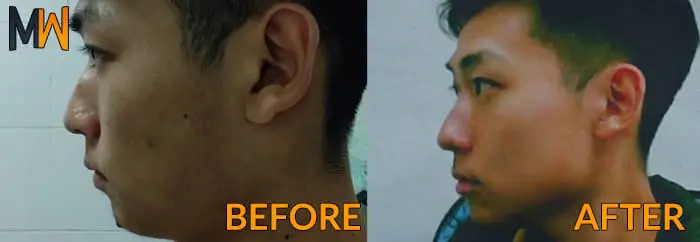
Suppose you look at your face from a side profile, not only does your jawline change with mewing, but so does your facial plane. The maxilla grows upward and brings the mandible along for the ride. Your face swings up and brings your jawline to a better position.
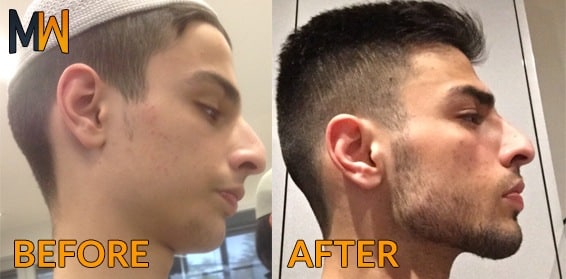
Improved Teeth Alignment
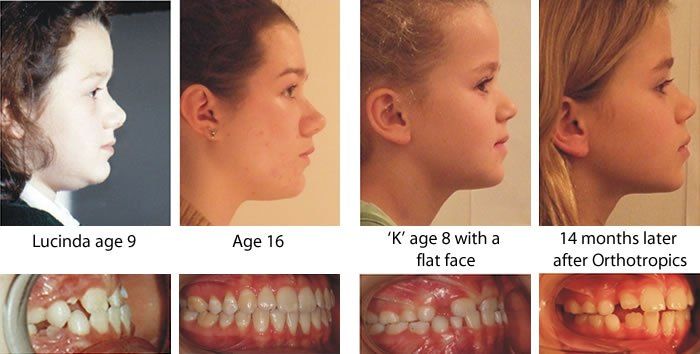
Getting a prominent jawline may be the primary reason most people get into mewing, but properly aligning crooked teeth is extremely beneficial. Crooked teeth are caused by not having enough space in the mouth to accommodate all the teeth. That’s why they’re also called “crowded teeth.”
Mewing helps in making sure that the maxilla and mandible are wide enough for teeth to develop. However, tongue posture is not as important as chewing hard foods when it comes to mandible development. The pressure on the jaw that comes from chewing is what causes the jaw to reach its full genetic potential.
The extra space provided helps in encouraging all the teeth to grow straight. We know that having crooked teeth is not great for self-confidence. It’s hard to smile and want to express emotions when you always have to hide your teeth.
Mewing saves the day for people with crooked teeth. Keep in mind though that having your crooked teeth fixed via mewing will take a lot of time and practice. If you want to achieve faster results, you can try mewing with a myobrace or just get braces or Invisalign via your dentist or orthodontist.
Better Gonial Angle
The jaw masseter muscles are antagonist muscles to the tongue. Mewing makes your neck muscles push up on your mandible and, over time, can improve the gonial angle. The gonial angle is difficult to change with tongue posture alone and is usually done in tandem with dedicated chewing (i.e., gum), which has been shown to balance out facial morphology and improve the gonial angle (Ingervall & Bitsanis, 1987).
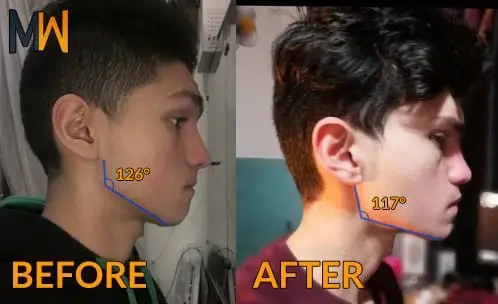
You can see the improvement in the gonial angle in the above picture (blue).
For more info on mewing, visit our Ultimate Guide, look at some before/after photos, and check out some of the studies supporting the principles behind mewing.

